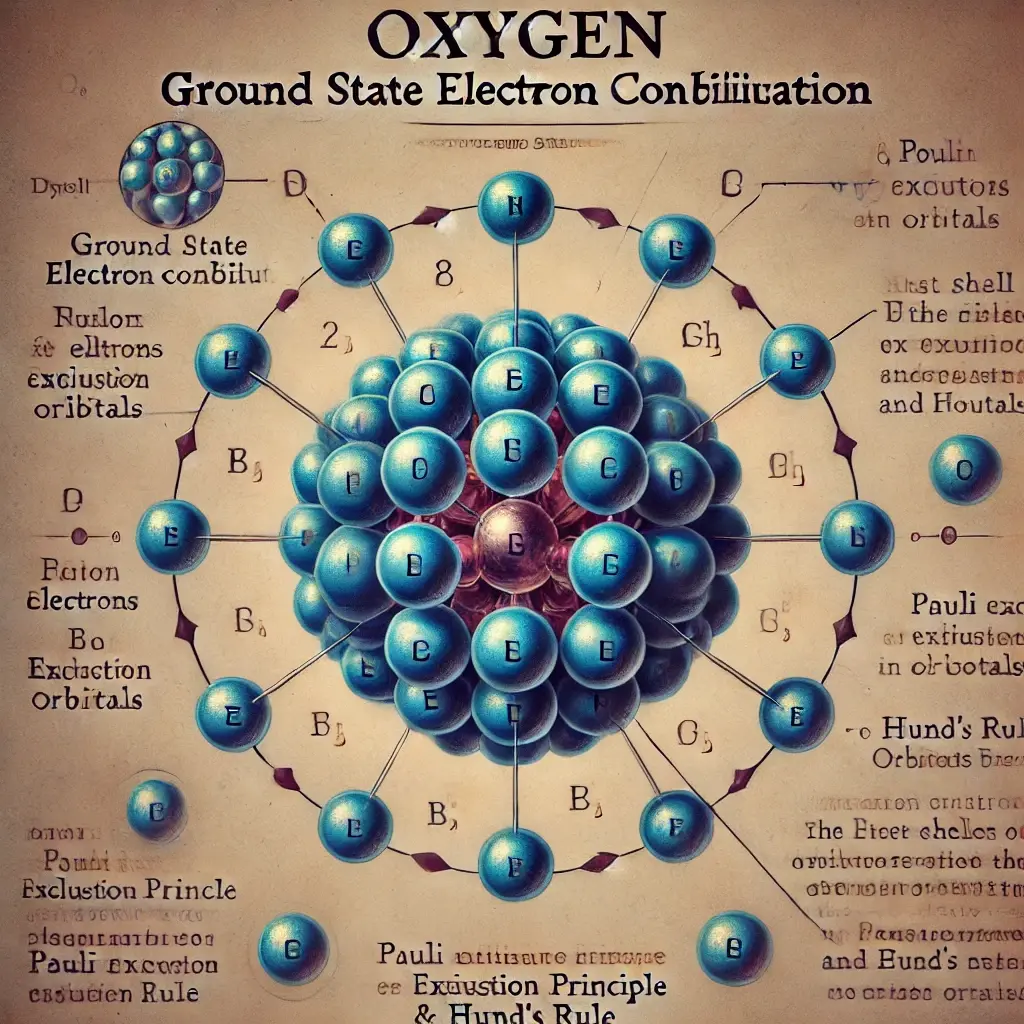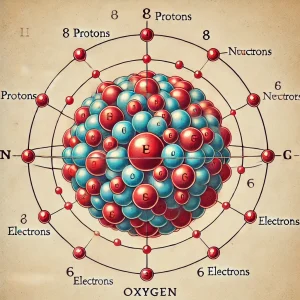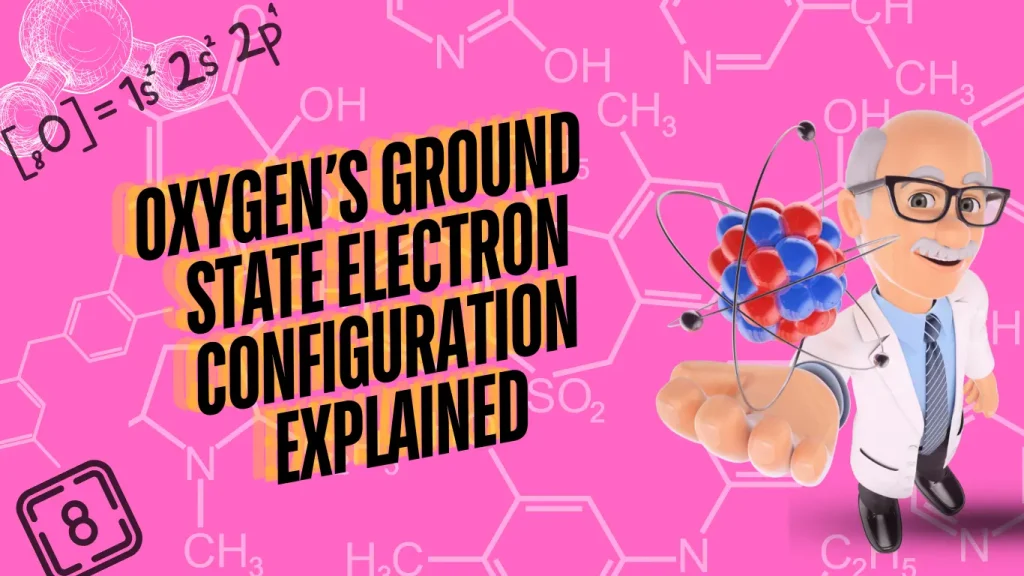Here is the Oxygen’s ground state electron configuration explained. Oxygen’s ground state electron configuration is 1s² 2s² 2p⁴.
Oxygen is a vital element found abundantly in the Earth’s crust and atmosphere. The explanation of Oxygen’s ground state electron configuration can be more easily understood. Determines How oxygen’s Electron Configuration Affects Reactivity And Bonding. The arrangement of electrons in oxygen’s orbitals follows the principles of quantum mechanics and helps explain its behavior in various chemical reactions.
Explaining oxygen’s ground state electron configuration is essential for understanding its role in forming compounds like water and organic molecules. This knowledge is crucial for chemistry, biology, and environmental science, where oxygen is fundamental in sustaining life and driving biochemical processes. Understanding oxygen’s electron configuration allows scientists to predict its interactions and reactivity.

Introduction To Electron Configuration
Electron configuration shows how electrons are arranged in an atom. Each element has a unique configuration. Electrons fill orbitals in a specific order based on energy levels. Lower energy levels fill before higher ones. The arrangement helps predict an element’s chemical behavior.
The electronic configuration of elements is crucial in chemistry. It helps explain how elements bond and helps understand reactivity. Chemists use this electronic configuration of elements to predict reactions. Knowing the electron configuration can help in designing new materials. It is a fundamental concept in studying chemistry.
The electronic configuration of elements refers to the distribution of electrons in the atom’s orbitals. Electrons occupy energy levels (shells), sublevels (subshells), and orbitals around the nucleus according to specific rules based on increasing energy and stability.
The electronic configuration of elements Basic Concepts:
- Shells: The principal energy levels, denoted by n (1, 2, 3,…). Each shell holds a maximum number of electrons given by (2n^2).
- Subshells: These are divided into four types based on the orbital angular momentum quantum number:
- s (sharp) subshell holds up to 2 electrons.
- p (principal) subshell holds up to 6 electrons.
- d (diffuse) subshell holds up to 10 electrons.
- f (fundamental) subshell holds up to 14 electrons.
The electron configuration is written by assigning electrons to orbitals in order of increasing energy, often represented using the Aufbau principle.
The electronic configuration of elements Notation
The standard notation represents:
- The energy level (n).
- The subshell type (s, p, d, f).
- The number of electrons in each subshell is written as a superscript.
For example:
- 1s² means two electrons in the 1st shell’s s orbital.
- 2p⁶ means six electrons in the 2nd shell’s p orbitals.
The electronic configuration of elements Principles to Follow:
- Aufbau Principle: Electrons fill orbitals starting with the lowest energy first (1s, 2s, 2p, etc.).
- Pauli Exclusion Principle: Each orbital can hold a maximum of 2 electrons with opposite spins.
- Hund’s Rule: Electrons prefer to occupy empty orbitals in the same subshell before pairing up.
Order of Filling Orbitals
The order of filling follows this sequence:
1s → 2s → 2p → 3s → 3p → 4s → 3d → 4p → 5s → 4d → 5p → 6s → 4f → 5d → 6p → 7s → 5f → 6d → 7p
Example Configurations:
- Hydrogen (H): 1 electron
Configuration: 1s¹ - Helium (He): 2 electrons
Configuration: 1s² - Carbon (C): 6 electrons
Configuration: 1s² 2s² 2p² - Iron (Fe): 26 electrons
Configuration: 1s² 2s² 2p⁶ 3s² 3p⁶ 4s² 3d⁶ - Uranium (U): 92 electrons
Configuration: [Rn] 5f³ 6d¹ 7s²
(Where [Rn] represents the configuration of the noble gas Radon)
Let me know if you’d like help with specific elements or concepts!
Atomic Structure Of Oxygen
From the atomic structure of oxygen, it has an atomic number of 8. This means it has 8 protons in its nucleus. In a neutral atom, 8 electrons orbiting the nucleus are arranged in different energy levels.
Oxygen has three main isotopes: O-16, O-17, and O-18. O-16 is the most common isotope, making up about 99.76% of natural oxygen. O-17 and O-18 are much rarer.

Principles Of Electron Configuration
Electrons fill the lowest energy orbitals first, which means the 1st orbital fills before the 2nd orbital. This principle helps predict the electron configurations of atoms. Electrons seek the most stable arrangement possible.
Each orbital can hold only two electrons. The electrons in the same orbital must have opposite spins. No two electrons can have the same four quantum numbers. This principle ensures electrons are uniquely arranged.
Electrons fill degenerate orbitals singly first. They pair up only when necessary, minimizing electron-electron repulsion. Electrons prefer to have parallel spins in separate orbitals, which leads to the most stable arrangement.
Electron Shells And Subshells
How many electrons are in each shell? Each shell can contain only a fixed number of electrons: the first shell can hold up to two electrons, the second shell can hold up to eight electrons, and the third shell can hold up to 18, continuing with the general formula of the nth shell being able to hold up to 2(n2) electrons.
Oxygen’s ground state electron configuration is 1s² 2s² 2p⁴. Electrons fill the lowest energy levels first, occupying shells and subshells.
Energy Levels
Electrons move in areas called shells. Each shell has a different energy level. Lower shells have lower energy. Higher shells have higher energy. Electrons fill lower energy shells first. This makes atoms stable.
Types Of Subshells
Each shell has smaller parts called subshells. Subshells are named s, p, d, and f. The first shell has only an s subshell. The second shell has s and p subshells. The third shell has s, p, and d subshells. The fourth shell has s, p, d, and f subshells.
Oxygen’s Electron Configuration
Oxygen’s electron configuration has eight electrons in total. These electrons are arranged in different energy levels. The first energy level holds two electrons, and the second energy level holds the remaining six electrons. This arrangement is known as the electron distribution.
The notation for oxygen’s electron configuration is 1s2 2s2 2p4. This shows how electrons fill the different orbitals. 1s2 means two electrons in the first s orbital, 2s2 means two electrons in the second s orbital, and 2p4 means four electrons in the second p orbital.
Learn more about Oxygen Electron Configuration in the main guide
Ground State Configuration
The ground state is when an atom’s electrons are in the lowest energy levels. It is the most stable state of an atom. Oxygen has eight electrons in its ground state. These electrons fill up the energy levels in a specific order. The electrons will first fill the 1s orbital, then the 2s orbital. Finally, they fill the 2p orbitals.
An atom is most stable in its ground state. Electrons occupy the lowest energy orbitals first. This configuration reduces the atom’s energy to a minimum. In the case of oxygen, the ground state helps it maintain stability. The electron configuration for oxygen in its ground state is 1s² 2s² 2p⁴. This setup makes oxygen less reactive compared to its excited states.
Electron Configuration Diagrams
Electron configuration diagrams are a visual way of showing how electrons are arranged around the nucleus of an atom. They represent the distribution of electrons in atomic orbitals, illustrating how the electrons occupy various energy levels, sublevels, and orbitals according to the rules of quantum mechanics. The diagram uses notation to depict the placement of electrons based on the electron configuration of an atom.
Key Concepts for Understanding Electron Configuration Diagrams:
- Energy Levels (Shells): Electrons occupy energy levels that are numbered 1, 2, 3, etc., corresponding to the distance from the nucleus. The higher the number, the further the energy level is from the nucleus.
- Sublevels (Subshells): Each energy level is divided into sublevels designated as (s), (p), (d), and (f). These sublevels have different shapes and capacities:
- (s)-subshell holds a maximum of 2 electrons.
- (p)-subshell holds a maximum of 6 electrons.
- (d)-subshell holds a maximum of 10 electrons.
- (f)-subshell holds a maximum of 14 electrons.
- Orbitals: Each sublevel consists of orbitals, which are regions where there is a high probability of finding an electron.
- The (s)-subshell has 1 orbital.
- The (p)-subshell has 3 orbitals.
- The (d)-subshell has 5 orbitals.
- The (f)-subshell has 7 orbitals.
- Pauli Exclusion Principle: Each orbital can hold a maximum of 2 electrons, which must have opposite spins (denoted by upward or downward arrows in diagrams).
- Aufbau Principle: Electrons first fill the lowest energy orbitals before moving to higher energy levels.
- Hund’s Rule: Electrons will fill empty orbitals within the same sublevel before pairing up in orbitals to minimize electron-electron repulsion.
Example of an Electron Configuration Diagram for Oxygen (Atomic number 8):
- Electron Configuration Notation:
Oxygen’s electron configuration is ( 1s^2 2s^2 2p^4 ). This tells us that:
- 2 electrons occupy the 1s orbital.
- 2 electrons occupy the 2s orbital.
- 4 electrons occupy the 2p orbitals.
- Diagram Representation:
In an electron configuration diagram, orbitals are represented as boxes or lines, and electrons are shown as arrows (↑ and ↓). Here’s how oxygen’s electron configuration would be represented:
1s: ↑↓ 2s: ↑↓ 2p: ↑↓ ↑ ↑This means:
- The 1s orbital has 2 electrons (↑↓), both paired.
- The 2s orbital has 2 electrons (↑↓), both paired.
- The 2p orbitals have 4 electrons, 2 paired (↑↓), and the remaining 2 unpaired (↑, ↑) in separate orbitals.
Applications Of Electron Configuration
Electron configuration helps understand chemical bonding. Atoms bond to achieve a stable electron configuration. Oxygen has six electrons in its outer shell. It needs two more to complete its shell, which leads to ionic or covalent bonds with other atoms.
Reactivity depends on electron configuration. Oxygen is very reactive because it needs two more electrons. It reacts with many elements to form oxides. These properties make oxygen essential in combustion and respiration.
Common Misconceptions
Many students think oxygen has an electron configuration of 2, 6. This is incorrect. The correct notation is 1s² 2s² 2p⁴. Each number and letter represents a specific part of an atom. “1s” means the first shell and “s” orbital. “2s” and “2p” mean the second shell with “s” and “p” orbitals.
Students often place electrons incorrectly in orbitals. Electrons fill orbitals from lower to higher energy. The correct order is 1s, 2s, 2p. Each orbital can hold maximum electrons. “s” orbitals hold 2, and “p” orbitals hold 6.
Frequently Asked Questions
What Is The Electron Configuration Of Oxygen?
Oxygen’s ground state electron configuration is 1s² 2s² 2p⁴. This means oxygen has two electrons in the 1s orbital, two in the 2s orbital, and four in the 2p orbital.
How Many Electrons Are In Oxygen’s Ground State?
Oxygen’s ground state has eight electrons. Two electrons occupy the 1s orbital, two occupy the 2s orbital, and four occupy the 2p orbital.
Why Is Oxygen’s Electron Configuration Important?
Oxygen’s electron configuration determines its chemical properties and reactivity. It explains why oxygen commonly forms compounds with other elements, such as water and carbon dioxide.
What Does The Term ‘Ground State’ Mean?
The term ‘ground state’ refers to the lowest energy state of an atom. In this state, electrons are in the closest possible orbitals to the nucleus.
Conclusion
Understanding oxygen’s ground-state electron configuration is essential for chemistry enthusiasts. It reveals how electrons influence chemical properties. Mastering this concept can enhance your grasp of chemical reactions. Dive deeper into electron configurations to unlock more secrets of the periodic table.
Keep exploring and learning for a stronger foundation in chemistry. Google Maps
